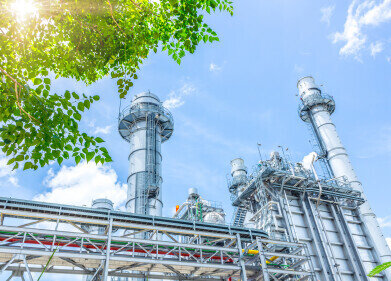Hydrogen Fuel
Increased production of green hydrogen could be essential for scalability of zero-carbon fertiliser
Nov 04 2023
The global agricultural sector stands on the precipice of a green revolution, one that is quietly being powered by hydrogen—green hydrogen, to be precise. As the world grapples with the twin challenges of feeding a burgeoning population and combating climate change, sustainable agriculture practices have become paramount. Among these, the creation of sustainable fertilizer through ammonia synthesized from green hydrogen is emerging as a pivotal solution.
Ammonia (NH3), a compound composed of nitrogen and hydrogen, is a critical ingredient in most synthetic fertilizers. Traditionally, the production of ammonia has been reliant on the Haber-Bosch process, which uses natural gas—a fossil fuel—to provide the hydrogen needed for the chemical reaction. This method is energy-intensive and contributes significantly to greenhouse gas emissions. In stark contrast, green hydrogen, produced through the electrolysis of water using renewable energy, offers a carbon-neutral alternative.
The role of green hydrogen in sustainable fertilizer production is multifaceted and significant. By replacing fossil fuels with green hydrogen in the ammonia synthesis process, the agricultural sector can drastically reduce its carbon footprint. This shift is not just environmentally imperative but also increasingly economically viable, as the cost of renewable energy continues to plummet and green hydrogen production becomes more cost-competitive.
Moreover, the decentralized production of green hydrogen could transform rural economies. Unlike natural gas, which requires a complex and centralized infrastructure, green hydrogen can be produced locally using solar or wind resources. This means that fertilizer production could be localized, reducing transportation emissions and stimulating local economies. Traditionally, ammonia synthesis has been an exceedingly high-tech operation, requiring heating the reactants to 300-500°C and cooling the resulting ammonia to -20°C, under pressures 150-300 times that of the atmosphere. However, earlier this year, researchers at the University of California, Berkeley, have engineered metal-organic frameworks (MOFs), porous materials that can capture and release ammonia efficiently at relatively moderate temperatures (around 175°C) and pressures. These MOFs are designed to sidestep the need for intense temperature fluctuations, conserving energy and promising a greener production path. Such a development could decentralize ammonia production, making it accessible to farmers worldwide, particularly in underprivileged regions, by potentially shifting production from large factories to smaller, local sites, or even directly on farms.
Furthermore, the integration of green hydrogen into ammonia production aligns with the circular economy principles. Excess renewable energy, which might otherwise be wasted during periods of low demand, can be utilized to produce hydrogen. This energy can then be stored in the form of ammonia and later used as a fertilizer, thereby creating a sustainable loop of energy and material flow.
The sustainable production of ammonia from green hydrogen also has implications for global food security. Fertilizers are essential for high crop yields, but the volatility of natural gas prices and supply can lead to unstable fertilizer prices, which in turn can jeopardize food production. Green hydrogen provides a more stable and predictable alternative, which could lead to more consistent fertilizer supply and prices.
Another critical aspect of ammonia's role in the future of sustainable fertilizer is its potential as an energy carrier. Ammonia can store and transport hydrogen energy efficiently over long distances. This feature could facilitate the international trade of green energy, as ammonia can be easily liquefied and shipped, unlike hydrogen gas.
However, challenges remain in fully realizing the potential of green hydrogen for sustainable ammonia production. The current production capacity of green hydrogen is not sufficient to meet global fertilizer demand, and significant investment is needed in electrolyser technology to scale up production. There is also a need for supportive policy frameworks to incentivize the transition to green hydrogen and to ensure that the benefits of this transition are equitably distributed.
Despite these challenges, the future looks promising. Initiatives such as the European Green Deal and various national strategies are beginning to prioritize green hydrogen as a key component of sustainable agriculture. Moreover, collaborations across sectors, from renewable energy providers to fertilizer manufacturers, are starting to emerge, underscoring a collective commitment to a sustainable future.
So, green hydrogen's role in creating sustainable fertilizer from ammonia is not only important—it's transformative. It represents a confluence of environmental stewardship, technological innovation, and strategic policy-making. By harnessing the power of green hydrogen, the agricultural sector can reduce its environmental impact, enhance global food security, and participate in a more sustainable, circular economy. The future of fertilizer—and by extension, global agriculture—is poised for a green overhaul, with ammonia at its heart, signalling a hopeful horizon for a planet in dire need of sustainable solutions.
Digital Edition
PIN 25.4 Aug/Sept
September 2024
Analytical Instrumentation - Novel and Rapid LSC method for the analysis of biogenic carbon in fuels Measurement and Testing - Matrix evaluation on the Xplorer-V with Vectra autosampler accordi...
View all digital editions
Events
Nov 04 2024 Abu Dhabi, UAE
Nov 04 2024 Kigali, Rwanda
Nov 05 2024 Toronto, Canada
Nov 05 2024 Paris, France
Nov 12 2024 Cologne, Germany




















